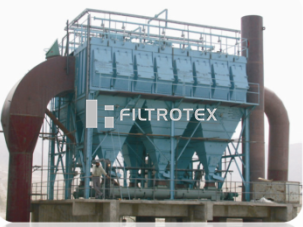FEF GLASS FIBER BAG FILTER
- Description
Description
FEF series of the bag filters are new products specially developed for exhaust gas dedusting of vertical kilns and dryers in the cement plant. Based on the characteristics of vertical kilns and dryers, the mode of air intake from above is used, to avoid the secondary dust blowing. Airflow is distributed uniformly in the inlet chamber, ensuring that depressurization is balanced in each bag chamber, in favor of improving the service life of the filter bag. The filter adopts the measures including microprocessor control, blowback in the filter chamber, timing and constant resistance deashing, temperature detection, etc., so that the filter can run efficiently and stably in the process of exhaust gas dedusting of vertical kilns and dryers. Even if the equipment does not shut down, the filter bag can also be changed separately in different chambers. The filter has the characteristics of simple, safe and reliable operation, low operating cost, so it is the equipment to effectively solve the problem of exhaust gas dedusting of vertical kilns and dryers.
Selection of filter cloth: When the temperature of waste gas needing to be treated is not more than 180℃ or moisture content is higher, CW300FCA anti-condensation filter cloth is adopted. The bending resistance, wear resistance and permeability of anti-condensation glass fiber filter cloth are better than those of glass fiber filter cloth handled by organic silicon. It is the optimal filter material for exhaust gas dedusting of vertical kilns and dryers, with an average service life of 1-2 years. When it needs to be disposed, it is required to select glass fiber cloth, of which the surface is treated by organic silicon or graphite. The treated filter cloth is soft, its hydrophobicity, bending resistance and wear resistance are improved, and the service life of 1-2 years can be guaranteed.
- Basic Structure
The basic structure consists of three parts:
Air intake, air exhaust and blowback system: includes air intake pipe, inlet chamber, air blowback pipe, Tee-junction switch valve and exhaust pipe.
Bag chamber structure: includes ash hopper, access door, ontology framework, top and bottom tube sheet, filter bag and bag chamber.
Ash discharging system: includes ash valve.
- Operating Principle
Under the action of the exhaust fan, dusty gas is inhaled in the air inlet main, and then into the inlet chamber through all air intake branches, evenly through the top tube sheet, and then enters into the filter bag. A large amount of dust are blocked on the filter bag, and parts of dust directly pass through the lower tube sheet and then into the hopper. Airflow is purified after passing through the filter bag. The purified gas enters into the induced draft fan through the vent valve, and then is discharged into the atmosphere.
After the filter runs for a period of time, dust on the surface of the filter bag is thickening. The resistance of the filter increases, when it increases to a certain value, the filter bag should be dedusted, namely, by applying external forces, dust on the inner surface of the filter bag is removed, so that the running resistance of the filter is reduced. When the resistance drops below the lower limit value, and the bag chamber puts into normal operation, the deashing process is mainly completed through blowback fan, tee-junction switch valve, etc. First of all, air brought by the blowback fan changes pressure inside and outside the filter bag, and the filter bag swells up and then shrinks. The dust layer on the surface of the filter bag is removed, and dust falls into the ash hopper. After a period of time, the blowback mouth is closed, and the air inlet is opened, so that the filter bag swells up again, in the state of normal operation. In the process of ash removal, dust falling into the ash hopper is discharged from the spiral conveyor through the ash valve. The deashing process is completed successively and separately in every chamber, without affecting the normal operation of the filter.
There are two deashing methods, i.e. timing deashing and constant differential pressure deashing.










